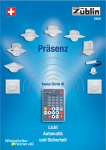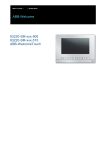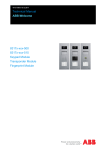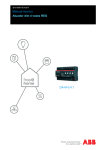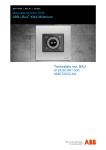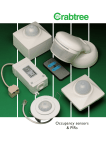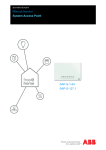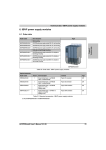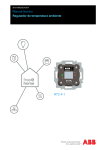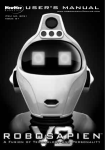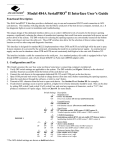Download Busch-Watchdog Manual for Electrical Specialists - Busch
Transcript
Tomorrow’s aspirations. Busch-Watchdog Manual for Electrical Specialists More security www.Busch-Jaeger.com Delivered today. 2 Contents Technology Applications 4–6 7 Operational safety/ Interference factors 8-9 Function overview 10 Range/Surveillance range 11 Installation Connection and settings 12–14 15 Remote control 16–17 Applications for special devices 18–19 Busch-Watchdog range 20 Busch-Watchdog flush-mounted range 21 Possible combinations of functions of flush-mounted devices for slave unit operation 22 Examples of typical circuits Troubleshooting 23–26 27 3 Technology The new professional class of Busch-Watchdogs is an assortment of outdoor movement detectors. Optimum detection and the pro- 4 fessional lens have long been the trademark of Busch-Watchdogs. The innovations include features that allow better adjustment, improved operation and easier installation. Basic principles The Busch-Watchdog is a passive infrared movement detector. It registers invisible infrared heat radiation. If the registered energy pattern changes as the result of movement, a pulse is activated. The range depends on the intensity of the infrared radiation and on its direction of movement. The BuschWatchdog is purely a receiver and transmits no signals itself. The connection between the heat source and the Busch-Watchdog is the ambient air. Under certain circumstances, the reception conditions are influenced by the prevailing weather conditions. As a result of the highly intelligent electronics, the BuschWatchdog can recognise this and largely compensates for range fluctuations. Detection through obstacles such as glass or vegetation is not possible. The detection principle All bodies with internal heat emit infrared radiation. The sensors used in the Busch-Watchdogs can detect this infrared radiation. The more distinct the radiation in relation to the surrounding area, i.e. the colder the outside temperature, and the more intensive the radiation of the detected body, the larger the sensor signal. The Busch-Watchdog reacts to large, rapid changes in temperature. Slow temperature changes and constant temperatures, such as the cooling of a car engine, do not activate the device. If a person moves directly towards the sensor, the increase in heat intensity is slow, and the unit is not, therefore, activated immediately. Where possible, the device should therefore be fitted at a right angle to the likely direction of movement to ensure reliable activation. Humid air (for example fog) can reflect the infrared radiation, resulting in reduced device sensitivity. Technology The optical system The range and detection angle of a movement sensor are determined mainly by its optics – i.e. the arrangement and design of the sensors used and of the lens. In the Busch-Watchdog 220 ProfessionalLINE, 3 highly sensitive sensors in combination with a mirror system and the perfectly matched lens result in a detection angle of 220 degrees. The lens and the mirror system receive and bundle the infrared radiation and project it onto the sensor. The sensitivity to movement within the detection zone is determined mainly by the number of lens seg- ments and their optical design. The available range depends on the size of the lens segments (optical magnification) and the electrical amplification factor. The lens system of the Busch-Watchdog, which is permanently connected to the sensor housing to provide a good seal for the unit, has an exceptionally high resolution for movement detectors. The possibility of monitoring "backwards" beyond the frame without loss of frontal range, for installation directly above doors or windows, is also unique. This is especially convenient when leaving the house. The following factors should be taken into account at the planning stage: The microprocessor The use of a microprocessor to control the Busch-Watchdog provides a series of valuable features: • Range stabilisation in a variety of weather conditions • Short-time pulse, e.g. for staircase timer switches • Suppression of inadvertent wrong operations to ensure that undesirable inadvertent operations due, for example, to moving trees, wind, etc. are largely filtered out. • Continuous light through NC switch Self-test A further advantage of the microprocessor used in the Busch-Watchdog 220/280 ProfessionalLINE and Busch-Watchdog 220 AlarmLINE is its built-in test function. Every time the supply voltage is connected or a restart occurs, an internal test program carries out a complete self-test. If this test is positive, the Busch-Watchdog switches itself on for at least approx. one minute or the set delay time. This confirms that the device is fully operational. • Dazzleproof e.g. against car headlights and torches • Precise digital time and dusk setting • Selectable simulated presence • Intelligent alarm function (separate surveillance zone) The most frequent direction of movement of an object with respect to the mounting – optimally, movement at an angle to the detection levels (see Fig. P. 4). Mounting height 2.5 m – this height ensures an optimum monitoring function and forms the basis of the range specifications. 5 Technology Each Busch-Watchdog of the new Professional class has been developed for a particular area of use. The diagrams show the various areas of use. With its many mounting and alignment options, the Busch-Watchdog can be optimally adapted to the local conditions. 220° Level 1 280° Level 2 90° The various detection levels To fully cover the surveillance zone, the Fresnel lens splits the zone into several overlapping levels. Levels 1 and 2 cover remote surveillance and ensure seamless detection when the surveillance zone is entered from the outside. Level 3 covers closerange detection to prevent undetected entry of the surveillance zone close to the wall. Level 4 covers the rearfield detection, which is activated when the front door is opened from the inside. Level 4 Level 3 Rearfield detection Additional protection for windows and doors up to the wall of the house, even in case of installation directly above doors and windows, is provided by the integrated rearfield detection. 6 Applications This table lists only some of the many possible applications. Busch-Watchdog Devices Application areas Buildings Private house Administrative buildings Hotels Schools Sports facilities Industrial buildings Multi-storey car-parks, basement garages Shops Transportation companies Car-parks Hospitals, old people's homes Furniture stores Trade fairs, exhibitions Tennis and squash courts High-shelf warehouses You will also find the appropriate version for your specific application. Busch-Watchdog 220 ProfessionalLINE, 280 ProfessionalLINE, 90 ProfessionalLINE Busch-Watchdog 220 SelectLINE Busch-Watchdog 220 AlarmLINE Busch-Watchdog 180 UP Standard/ Comfort II Corridors, hallways, cellars, changing rooms, rest rooms loading bays, showrooms, outdoor areas, garages, terraces etc. Animal path in outdoor areas, storage rooms Outdoor areas, terraces, loading ramps Hallways, corridors, cellars, libraries, offices • • • • • • • • • • • • • • • • • • • • • • • • • • • • • • • • • • • • • 7 Operational safety/interference factors The high-capacity relay To allow the connection of high loads without needing an additional auxiliary relay and the connected installation work, only tested highcapacity relays are used. Beside the high switching capacity of up to 3,680 W/VA with- out additional contactor relays, these relays guarantee high service life of the device. Automatic range stabilisation The range normally fluctuates between 50 and 100% depending on the prevailing ambient conditions. The BuschWatchdog recognises the ambient conditions. A built-in microprocessor with intelligent software then controls the internal electronic amplification to reduce weather-induced range fluctuations to a minimum. Automatic interference suppression This is another feature made possible by the built-in microprocessor of the Busch-Watchdog. If, for example, the detector switches on due to sunlight, wind and moving bushes, the detection logic recognises this and suppresses many of the unwanted operations by adjusting the operating mode. External light protection With the dusk sensor set to "dark", the Busch-Watchdog could be deactivated by a light source (torch or car headlights). To avoid this situation and therefore increase security, the BuschWatchdog leaves its current monitoring function unchanged for 90 seconds if the light conditions suddenly Security zone up to 6 change. m Range up to 16 m 8 Operational safety/interference factors Wrong operation The principle of operation of a passive infrared movement detector means that its function depends on the physical conditions in the detection zone. When heat sources move and the response threshold of the BuschWatchdog is exceeded, operation is triggered. Sunlight has a high percentage of natural infrared radiation. If the sun shines, for example, onto a bush or a tree in Range fluctuations In extreme weather conditions, the size of the detection zone may change. High outside temperatures and poor visual conditions due to fog, rain or snow can temporarily reduce the range. Excessively long ranges are caused by close-by sources of extreme heat, such as lorries or buses, and at very low outside temperatures and good visual conditions. It is important here to set the detection range to the required distance during installation by adjusting the angle of the Busch-Watchdog the detection zone and this bush or tree moves in the wind, this may cause a movement detector to trigger. Sunlight reflecting off glass or water, a heat source cooling down (e.g. a lamp mounted nearby) or animals in the detection zone can also trigger detection. ment detector. This can be prevented by using surge voltage protectors or a special RC element. For further information about this, see the troubleshooting section. Mains voltage peaks, caused, for example, by switching inductances such as relays and contactors on and off, can also activate a move- sensor and, if necessary, by using BuschWatchdog masking strips. The automatic range stabilisation of the Busch-Watchdog counteracts the effects described above, but, for physical reasons, it cannot guarantee a complete elimination of all unwanted switching operations under all conditions. 9 Function overview Busch-Watchdog 90 ProfessionalLINE 220 ProfessionalLINE 220 SelectLINE 280 ProfessionalLINE 220 AlarmLINE 220° 4 • • • 16 m 16 m • 6m 6m • • • • • • • 10 AX1) 10 AX2) • -25°- +55 °C • • • • • • • IP 55 • • • • • 6849 AGM-35 6849 AGM-201 6849 AGM-204 6849 AGM-208 surface-mounted Detection angle 90° Surveillance levels 4 Close-range detection • Rearfield detection • 1st detection zone • Range, frontal (max.) 12 m Range, lateral (max.) 6m 2nd detection zone Range, frontal (max.) Range, lateral (max.) Direction-independent detection2) Sensitivity adjustable Microprocessor Autom. range stabilisation Autom. interference suppression Dazzle-proof Integrated test function • High-capacity relay 16 AX1) Additional switch output Potential-free switch contact3) Temperature range –25°– +55 °C Dusk sensor •4) Off-delay •4) 5) Compulsory cutout after 90 mins Short-time pulse (1 s) Suitable for incandescent lamps • Suitable for fluorescent lamps • Suitable for low-voltage halogen lamps • Water protection IP 55 Wall mounting • Ceiling mounting • • Corner mounting6) Masking strips (cover foil) • Remote control anthracite 6853 AGM-35 brown 6853 AGM-201 white 6853 AGM-204 silver metallic 6853 AGM-208 1) 220° 4 • • • 16 m 16 m 220° 1 • 16 m 16 m 280° 4 • • • 16 m 16 m • • • • • • 16 AX1) • • • • • • 16 AX1) • • • • • • 16 AX1) –25°– +55 °C • • • • • • • IP 55 • • • • • 6845 AGM-35 6845 AGM-201 6845 AGM-204 6845 AGM-208 –25°– +55 °C • • • • • • • IP 55 • • • • • 6845 AGS-35 –25°– +55 °C • • • • • • IP 55 • • • • • 6848 AGM-35 6848 AGM-201 6845 AGS-204 6848 AGM-208 X designation: relay can also switch capacitive loads. For detection in the security zone. For the 2nd detection zone (6 m). Simultaneous switching with 1st detection zone (16 m) can be activated via infrared service manual transmitter 6842. 4) Combined adjustment for dusk sensor and off-delay. 5) Can be deactivated via infrared service manual transmitter 6842. 6) With corner adapter 6887-xxx. 2) 3) 10 Range/Surveillance range A high surveillance density is crucial to guarantee the detection quality of a movement detector. In the BuschWatchdog, up to 416 closely packed, large- Busch-Watchdog 90 ProfessionalLINE area switching segments monitor the surveillance zone in up to 104 sectors. This large number of operating points guarantees reliable switching even for small movements. Its wide range of up to 16 m at the front and to both sides is unique. The detection range is affected by the following factors: • Installation site and height • Horizontal and vertical alignment • Direction of movement in the detection zone • Local weather conditions Rearfield detection Range up to 12 m 6m Busch-Watchdog 220 AlarmLINE 6m Rearfield detection Security zone 6 m Range up to 16 m Busch-Watchdog 220 ProfessionalLINE Rearfield detection Busch-Watchdog 220 SelectLINE Range up to 16 m Busch-Watchdog 280 ProfessionalLINE Range up to 16 m Rearfield detection Range up to 16 m 11 Installation To ensure that the Busch-Watchdog functions optimally, the following information and installation preconditions or minimum distances must be observed. Installation instructions 1 2,5 m The Busch-Watchdog must be mounted on a solid wall, since each detector movement has the same effect as a movement of a heat source in the surveillance zone. 4 To optimise detection, install the device at an angle to the detection levels. A directly approaching heat source is not detected as reliably as one moving across the detection zone. Since infrared waves cannot penetrate solid objects, make sure that nothing obstructs the line of vision of the BuschWatchdog. 12 2 3 When specifying the mounting location and height, take into account the distances to the road and to neighbouring properties etc. to avoid unwanted triggering. Installation at a height of 2.5 m. This is the optimum installation height. The readings given here (see P. 10) were taken at an ambient temperature of 20 °C with an approach from the side (range fluctuations, e. g. on account of weather conditions: see Page 8). 5 6 Every passive infrared movement detector responds to a fast change in local heat radiation. For example, raindrops on the lens may deflect the heat radiation, disturb the local conditions and trigger switching. To prevent inadvertent switching operations, the Busch-Watchdog should therefore be installed so that it is protected from rain, wind and direct sunlight as far as possible. The housing of the Busch-Watchdog is adequately protected against water spray, allowing an outdoor installation without additional water protection. The minimum distance between the Busch-Watchdog and the switched lights is 1.5 m. The temperature change of a light installed near the sensor could otherwise cause the sensor to reactivate after it has been switched off. Spotlights should not be aimed directly at the Busch-Watchdog. Installation The new Professional class has new possibilities for setting the Busch-Watchdog. The head of the BuschWatchdog can now be adjusted on 3 axes. 7 +90° –40° The range to the front can be adjusted by turning and tilting the sensor component, and to the side by partial covering of the lens (masking strip, see Page 14). Inclined locations can be compensated by lateral turning (+/– 30°) of the Busch-Watchdog on the wall connection boxes. 8 ±30° ±30° –30° +30° If parallel inductances such as relays, fluorescent lamps or transformers are switched with the Busch-Watchdog, we recommend the use of an RC suppressor (order no. 6899) parallel to the consumer. Because the BuschWatchdog is an electronic device, the installation of a surge arrester parallel to the power supply is advisable, since parallel inductances can cause overvoltages in the range of 3,000 - 4,000 volts. 9 The adjusters must always point downwards after installation, otherwise the direction of detection is upwards. 10 Movement detectors are not suitable as special burglar alarm systems, as they do not have the tamper protection required for this function. 11 Ceiling mounting For installation e.g. under roof projections, canopies and balconies, the Busch-Watchdogs ProfessionalLINE and AlarmLINE are optimally designed. The devices can be prepared for the respective mounting position by simply rotating the sensor housing. Again, the adjustment screws must point downwards after installation. Important: Observe correct installation height (approx. 2.5 m)! 12 Installation in lighting control systems For installation e.g. in hallways and corridors of administrative buildings, it is essential to adapt the surveillance zone to the local conditions. For installation, for example, in entrance halls and corridors of office buildings, note that the best results are obtained with movements across the surveillance zone. To bridge downtimes, the time should be set as high as possible. 13 Installation In principle, all BuschWatchdogs can be mounted on ceilings, walls or even in corners. Wall mounting Busch-Watchdog ProfessionalLINE Busch-Watchdog 220 AlarmLINE Restricting the detection zone Ceiling mounting Busch-Watchdog ProfessionalLINE Busch-Watchdog 220 AlarmLINE Corner mounting Busch-Watchdog 280 ProfessionalLINE 14 The masking strips With the masking strips, areas that are not to be monitored can be specifically excluded from the surveillance zone. The masking strips can also be used to adjust the surveillance range for distinct surveillance zones. Tip: With the corner adapter (order no. 6887), the unit can be fitted to a house corner or downpipes. Connection and settings To match the BuschWatchdog ProfessionalLINE 220/280 and AlarmLINE units perfectly to the ambient conditions, the follow- The watchdog is connected with the wallmounted socket. The Watchdog is simply clipped into place (bayonet catch). T/ S 30 15 5 1 min 10 s N + N - + A ing variables are externally adjustable: Test/Standard operation (T/S) In this operating mode, the shortest time setting of two seconds always applies in the daytime to define the surveillance zone irrespective of the set delay time. After the test phase of 10 mins, the Watchdog automatically changes back to the Standard operating mode. Test function To simplify adjustment during installation, the delay time is set to two seconds in the Test position. The dusk sensor is then disabled. Once the desired setting has been found after testing the settings in the surveillance zone, select the desired delay time and the dusk value to complete the installation. Standard operation The delay time (3 mins) and the dusk value (4 Lux) are specified. Time setting It specifies the delay time activated after the surveillance zone is vacated. Beside exact time settings, a shorttime pulse is provided. Short-time pulse ( ) e.g. for activating bell systems. Every 10 s a pulse lasting 1 s is generated. With the Busch-Watchdog 220 AlarmLINE, the short-time pulse only affects switch output 1. Note: (only 220 AlarmLINE) The delay time of the 2nd Switch output is limited to max. 3 mins. The warning lamp (if activated via infrared service manual transmitter) has a fixed delay time of 30 s. Sensitivity The Busch-Watchdog works in 3 sensitivity level settings. Level N (Normal) is standard. Greater sensitivity + is e.g. intended for interior applications. In the operating mode – the sensitivity for a busy environment (trees or bushes) is reduced. Comfort mode (only 220 AlarmLINE) In all sensitivity level settings the Busch-Watchdog 220 AlarmLINE works in comfort mode and serves to switch 2 different illumination zones. Alarm mode (only 220 AlarmLINE) With the Busch-Watchdog 220 AlarmLINE, in this operating mode the warning light and the direction-dependent switching of the 2nd detection zone (security zone) are activated. After the value drops below the set brightness threshold when the security zone is entered from outside the 2nd switch output is activated for max. 3 mins and the warning lamp for 30 s. In event of additional detection, the delay time restarts. When the person moves away from the Watchdog, there is no reaction from the warning light and switch output of the security zone. Only the switch output of the normal detection levels (1– 4, see P. 6) is switched depending on brightness. Dusk setting Specifying unit activity according to ambient brightness (0.5 – 300 Lux, daytime operation). Tip: By activating the function "Day operation for alarm evaluation" via the infrared service manual transmitter (see P. 17) the security zone can also be monitored during the day. 15 Remote control With the two infrared manual transmitters or an additional button, the most important functions of the BuschWatchdog can be activated. ON OFF ON OFF ON This also applies for the simulation of presence in which the BuschWatchdog switches to continuous light at dusk and later to normal operation. OFF Via NC switch (manual operation) By means of an NC switch in the supply line of the movement detector, the light can be switched on for the duration of the delay time set at the unit. If during this time the movement detector detects movement, the connected lamp remains switched on. Note: (only 220 AlarmLINE) Operation via NC switch only acts on switch output 1 (detection levels 1–4, see P. 6). Via infrared manual transmitter Continuous light If this function is activated, the relay output switches permanently for 4 hours. After this period, the previous operating mode is automatically reactivated. Deactivation: Early termination of the 4 hours' continuous light and return to operating mode that was active before the ON button was pressed. Simulated presence This operating mode combines the functions of a movement detector with those of a traditional dusk switch. The connected lighting is switched on at dusk by approx. 22.30 or 23.30 (summer time). At the end of this permanent light phase, the device reverts to normal detection. Operation The movement detector measures the outside light parameters and learns in which season it is working. The internal time basis is then adjusted accordingly (e.g. extended in autumn/winter). The continuous light has no effect on the 2nd switch contact and the warning lamp (only 220 AlarmLINE). BUSC H-JAEG ER ON OFF ON OFF BUSC H-JAEG ER 16 ON OFF Note: When the short-time pulse is set, the switch output is cycled 1 s ON and 55 s OFF to control time switches. Note: When the short-time pulse is set, during the continuous light phase the switch output is cycled 1 s ON and 55 s OFF to control time switches. The continuous light phase does not act on the 2nd switch contact and the warning lamp (only 220 AlarmLINE). Remote control The infrared service manual transmitter has been developed especially for operation at the customer. Additional monitor functions, test operation and setting of the activation can be conveniently operated remotely or adjusted. This is a particular advantage with units mounted high. ON ON ON ON 90min. Alarm Test ON OFF ON OFF ON OFF ON OFF ON OFF OFF Continuous light (4 hrs) On/Off (see P. 16). Activation of this function ends the test operation. OFF N ON OFF + RESET Sensitivity is selectable. In-house operation (+), normal (N) or busy (–) environment (trees/ bushes in surveillance zone). Alarm Flashlight 1+2 OFF S E N S IT IV IT Y N B U S C H -J A E G E R ON Via infrared manual transmitter ON 90 min OFF Compulsory cutout After 90 mins, the Watchdog switches the light off for approx. 2 s in order to determine the current ambient brightness in this period. The light is then switched back on depending on the detected movement and the set brightness switch threshold. Factory setting: always deactivated. ON Alarm OFF (only Busch-Watchdog 220 AlarmLINE) Activating/deactivating the 2nd switch output (for detecting in the security zone). Factory setting: always activated. ON OFF ON Test OFF This function activates the test operation for an unlimited period, independently of the parameters set at the Busch-Watchdog. Continuous light and simulated presence are terminated. The test mode is exited via the "TEST OFF" button. In the T/S operating mode, standard mode or alarm mode is immediately activated (only Busch-Watchdog 220 AlarmLINE). Note: Activation of the continuous light and simulated presence also terminates the test operation. Alarm + OFF (only Busch-Watchdog 220 AlarmLINE) Activate/deactivate day operation (brightness sensor switched off) for evaluation of the security zone. Factory setting: always deactivated. ON Flashlight OFF (only Busch-Watchdog 220 AlarmLINE) Activates/deactivates the warning lamp (detection in the security zone). Can be cut in in comfort mode and deselected in alarm mode. OFF (only Busch-Watchdog 220 AlarmLINE) Activate/deactivate direction recognition during alarm operation. When the Watchdog is approached (previous penetration of detection levels 1 or 2 see P. 6, and subsequent entry of the security zone), the 2nd switch output and the warning lamp are switched on. But not when the person moves away from the Watchdog or is present in the security zone. Factory setting: deactivated in comfort mode, activated in alarm mode. ON 1+2 RESET Resetting to factory settings or values set at the device for sensitivity and operating mode. All parameters set via the infrared service manual transmitter are cancelled. OFF (only Busch-Watchdog 220 AlarmLINE) Activate/deactivate synchronous operation. The two relays switch synchronously with the Busch-Watchdog AlarmLINE. The detection levels 1– 4 (see P. 6) are evaluated here. Detection in the security zone is only indicated via the warning lamp, if activated. Factory setting: always deactivated. ON OFF Simulated presence On/Off (see Page 16). Activation of this function ends the test operation. 17 Applications for special devices – In addition to the basic functions, the BuschWatchdog Professional offers numerous advantages in day-to-day operation. Busch-Watchdog 220 SelectLINE The particularly narrow, disc-shaped monitoring zone of the Busch-Watchdog 220 SelectLINE makes it attractive for various applications in industrial and private use. Horizontally aligned detection covering a large flat area can provide the desired effect of precise, spatially limited monitoring of properties or car-parks. In contrast, a vertical surveillance zone is suitable with appropriate installation e.g. for warehouse aisles at large industrial sites. 5° Ceiling-mounted Busch-Watchdog 220 SelectLINE 5° Wall-mounted Busch-Watchdog 220 SelectLINE 18 With an installation height of e.g. 1.5 m – horizontally aligned – there is an approx. 1 metre high area outside the detection zone. So small animals are not detected, but humans are. On account of its special function and area of application, the Busch-Watchdog 220 SelectLINE is not equipped with rearfield monitoring. Applications for special devices The security provided by the Busch-Watchdog 220 AlarmLINE is unsurpassed. The light gives anyone approaching the house the impression that they have been seen. This is made possible with the additional security zone. The range of the security zone is about six metres to the front and to both sides. 6m If someone enters this inner zone from outside, the red warning light is activated and a signal applied to an additional potential-free output. The two signals can be cut out separately via the optional infrared service manual transmitter. At this 2nd output, an additional light can be connected or a signal can be sent to the control panel in the interior. Alarm mode The alarm mode is intended for monitoring a security zone at a distance of 6 m to the Busch-Watchdog 220 AlarmLINE. The potential-free switch output of the security zone can be combined e.g. with a monitoring camera. The parallel transfer of information and alarm signals to the room and control panel is possible. area of the security zone is then entered, the 2nd switch output and the warning lamp are activated. A connected monitoring camera delivers the video information to the house and via the parallel ABB Powernet EIB or ABB i-bus® EIB/KNX binary input corresponding messages are issued to the room and control panel. If the house is left or only a movement detected in the security zone (without previous detection in the remote level), only the outside lighting is switched on. Upon request (see P. 17, remote control) the monitoring camera can be activated and signals sent to the room and control panel also in the daytime. When the house is approached, at dusk the lighting is first switched on. If the Zone 1 Zone 2 16 m Comfort mode (2-zone operation) The Busch-Watchdog 220 AlarmLINE performs in this function like 2 independent movement detectors. Depending on the distance from the monitored house, 2 different surveillance zones can be evaluated separately. For example, at a distance of 6 – 16 m the path lighting is switched on, and if the person further approaches the house (< 6 m), the door entrance lighting is activated. When the For additional connection images, see P. 24/25. person moves away from the house, the two light sources switch in the reverse order. At dusk, in the direct vicinity of the Watchdog, e.g. when somebody goes to the letterbox or dustbin, only the door entrance lighting is activated. 19 Busch-Watchdog range The entire BuschWatchdog range includes movement detectors for outdoor areas and the flushmounted devices for interior and outside areas, as well as various accessories. Movement detector Flush-mounted devices Busch-Watchdog 220 AlarmLINE. The security professional. Busch-Watchdog 220 ProfessionalLINE. The universal professional. Busch-Watchdog 280 ProfessionalLINE. The professional for house corners. Busch-Watchdog 90 ProfessionalLINE. The professional for terraced houses. Movement detector Surface-mounted devices/accessories Corner adapter for Busch-Watchdog ProfessionalLINE Infrared manual transmitter Infrared service manual transmitter Flush-mounted devices/presence indicators Busch-Watchdog 180 UP Comfort II Busch-Watchdog 180 UP Standard Busch-Watchdog Allwetter 44 RC element *Request separate user manual 0001-0-0222. Busch-Watchdog Präsenz tech1) 20 Surface-mounted housing for Busch-Watchdog Präsenz tech1) Infrared manual transmitter for Busch-Watchdog Presence tech Busch-Watchdog 220 SelectLINE. Won't be disturbed by small animals. Busch-Watchdog flush-mounted range The table shows the flush-mounted range including the presence indicator in overview. Busch-Watchdog flush-mounted range Allwetter 44® Comfort II * 6800-2X-104 6800-8X-104 6800-7X-104 6813-xxx-101 6800-21X-104M 6800-2X-104M 6800-8X-104M 6800-7X-104M 6800-3X-102C Multi lens Select lens 6800-21X-104 Combination lens Standard 6810-212/214-101 IP 44 Frost-proof to –25 °C Important! Outdoors, use only with 6401 U-102 *Switch-off behaviour: In combination with 6593 U (soft Off function), the Comfort II sensor dims down and switches off within 60 seconds. L 6812 U-101 6593 UU 6593 6804 U-101 6402 U 6402 U 6805 U 6401 U-102 2020 US (NO switch) MOSFET unit 60-420 W/VA 2-wire technology Relay unit 700 W/VA 3-wire technology Detection levels Surveillance zone Mounting height Front 0.8 – 1.2 m 12 m 8m Horizontal Vertical Fit masking strips on sides. No narrowing possible since there is only one detection level. Fit masking strips on sides. By covering the wide range, detection can be limited to the close range. 8m 12 m Front 10 m 12 m 15 m Side 2.5 m 4m 5m Mounting height 1.2 m 2.0 m 2.5 m 5° 25° Remote Near 10 m 12 m 15 m 2m 3m 3.5 m 15 m 5° 10 m 0,8 m – 2,5 m Universal relay unit 2.300 W/VA 3-wire technology ca. 2° Mounting height 1.2 m 2.0 m 2.5 m Multi lens Slave unit 3-wire technology Narrowing the detection zone Side 8m 12 m 0,8 m – 1,2 m ca. 3° Select lens Universal central dimmer Universal serial unit 2.300 W/VA 60-420 W/VA 3-wire technology 2-wire technology Mounting height Front 1.2 m 9m 2.0 m 12 m 2.5 m 15 m Side 4m 8m 10 m Fit masking strips on sides. 5° 15 m 5° 12 m 7° 9m 0,8 m – 2,5 m Combination lens 5° By covering the wide or medium range, detection can be limited to the medium or close range. Mounting Remote Middle Near height 1.2 m 9m 3m 1m 2.0 m 12 m 8 m 3m 2.5 m 15 m 11 m 3.5 m 5° 18° 5° 21 Possible combinations and functions of flush-mounted devices for slave unit operation The flush-mounted devices can be functionally extended – with a slave unit. The table shows an overview. Flush-mounted inserts Sensors Slave unit Function 6812 U-101 6810-21x-101 6800-xxx-104 (M) NC switch1) NC switch1) 6813-101 NC switch1) 6810-21x-101 NO switch 6805 U NO switch 6813-101 NO switch2) 6805 U Switches on for 80 s, independently of ambient brightness Switches on for the set period (min. 1 min for time settings less than 1 min; exception short-time pulse ) Switches on for the set period (min. 1 min for time settings less than 1 min; exception short-time pulse ) Switches on for 80 s, independently of ambient brightness 160 s as addition of main and slave units Switches on for the set period (min. 1 min for time settings less than 1 min; exception short-time pulse ) Setting of short-time pulse Switches on for the set period (exception short-time pulse ) Setting of short-time pulse and daytime operation Switches on for 80 s, independently of ambient brightness 160 s as addition of main and slave units Switches on for the set period (min. 1 min for time settings less than 1 min; exception short-time pulse ) Setting of short-time pulse Switches on for the set period (min. 1 min for time settings less than 1 min; exception short-time pulse ) Switches on for the set period (exception short-time pulse ) Setting of short-time pulse and daytime operation Flush-mounted inserts Sensors Slave unit Function 6402 U 6810-21x-101 NO switch 6805 U NO switch Switches on for 80 s, independently of ambient brightness 160 s as addition of main and slave units Switches on for the set period (min. 1 min for time settings less than 1 min; exception short-time pulse ) Setting of short-time pulse Switches on for the set period (exception short-time pulse ) and heating, air-conditioning and ventilation control Setting of short-time pulse and daytime operation Switches on for 80 s, independently of ambient brightness 160 s as addition of main and slave units Switching for the set period. In the operating mode Soft off, at the end of the switch-off delay time of 60 s the light is dimmed and switched off Setting of short-time pulse Constant light control for the set time (Exception short-time pulse ) Setting of short-time pulse and daytime operation 6804 U-101 6800-xxx-104 (M) 6800-xxx-104 (M) 6805 U NO switch2) 6805 U NO switch 6805 U NO switch 6800-3x-102C 6805 U NO switch 6813-101 6401 U-102 6810-21x-101 6800-xxx-104 (M) 6813-101 6593 U 6550 U-101 6805 U 1) 2) 6800-xxx-104 (M) 6805 U NO switch 6805 U NO switch 6813-101 6805 U NO switch 6810-21x-101 6805 U – 6800-xxx-104 (M) – 6813-101 – 6810-21x-101 Slave unit function via interruption of operational voltage >2 s. With longer operation >1 s. 22 6805 U NO switch Retriggering respective main unit to extend surveillance zone Examples of typical circuits for surface-mounted units LS 16 A L N N NC switch L Lamp Busch-Watchdog LS 16 A L N 3-stage switch 1 2 3 N Lamp L Busch-Watchdog switched on through NC switch If the power supply of the Busch-Watchdog is intermittently interrupted in standby mode and then reconnected, the lights are switched on automatically for the set delay time. Function selection of outdoor lighting The following functions can be selected via the 3-stage switch 2713 U or 2710 U: 1. Continuous light 2. Light switched off 3. Movement detector operation Control switch for switching over to PERMANENTLY ON In Busch-Watchdog operation, the control lamp signals that the connected light has been switched on (status signal). Tip: The toggle control switch insert 2000/6 USK can be used (so that the control lamp can be connected to the neutral wire). Busch-Watchdog LS 16 A L N L N Lamp Control Off switch Busch-Watchdog Parallel operation of several BuschWatchdogs E.g. combined with a continuous light switch for several house sides. LS 16 A L N L N L N L N Lamp Off switch Busch-Watchdog 23 Examples of typical circuits of Busch-Watchdog AlarmLINE LS 10 A L N N L Lamp 2 Busch-Watchdog AlarmLINE Comfort mode of Busch-Watchdog AlarmLINE 2 independent light circuits are switched depending on the distance to the movement detector, e.g. path and house door lighting. Lamp 1 Increase of total switching capacity to 2x 2.300 W/VA LS 10A L N N L Lamp 2 Busch-Watchdog AlarmLINE Lamp 1 Switching low-voltage signals with the Busch-Watchdog AlarmLINE LS 10 A L N NC switch Lamp N L Busch-Watchdog AlarmLINE Bell LS 10 A L N Powernet EIB binary E1 E2 input N L N L Busch-Watchdog AlarmLINE 24 Note: The two switch outputs can be coupled via the infrared service manual transmitter (synchronous operation). Lamp Note: The voltage range for the potential-free switch output is between 12 V ~ to 48 V ~, at min. 10 mA to max. 1 A. Coupling the BuschWatchdog AlarmLINE to ABB Powernet EIB E.g. for further processing detection signals at the room/control panel. ON Alarm OFF Actuate the button on the infrared service manual transmitter. Tip: The two switch outputs can be coupled via the infrared service manual transmitter (synchronous operation). Tip: The following ABB Powernet EIB binary inputs can be used: 6963 U, 6967/60 or 6956 EB. Important: For reasons of standards, electronic switches must only switch one phase. ON 1+2 OFF Actuate the button on the infrared service manual transmitter. Examples of typical circuits for surface-mounted/flush-mounted units LS 10 A EIB-Bus L N + – ñ + N L E1 E2 LS 16 A L N N L Lamp Busch-Watchdog RC element Connection of an external relay/ contactor • Extension of the Off delay • Activation of a pulse relay (e. g. for flashing lights) • Activation of a staircase light timer switch • Increase of switching power to more than 3,680 W/VA Note: With the BuschWatchdog in combination with a staircase light timer switch, the short-time pulse setting (1 s) must be selected. Note: For illuminated switches, a separate N is required. Note: In combination with the Busch Universal Central Dimmer® 6593 U, in operating mode 4 "Soft OFF", the light is dimmed within 60 s and then switches off. Time/ flashing relay LS 16 A L N Lamp L N Two-way circuit Tip: The following ABB ibus® EIB/KNX binary inputs can be used: 6156 EB, 6188/13, 6188/16, 6197/11-102, 6172 AG-101 or 6173 AG-101. Installation bus EIB binary input Lamp Busch-Watchdog AlarmLINE Coupling the BuschWatchdog AlarmLINE to ABB i-bus® EIB/KNX E.g. for further processing detection signals at the room/ control panel. Busch-Watchdog LS 16 A L N * Lamp NO switch 1 N L Busch-Watchdog Combination of an existing twoway circuit with Busch-Watchdog/ Busch-Watchdog 180 UP Two-way circuit and movement detector have the same priority. Activation of lighting with Busch-Watchdog 180 UP Standard or Comfort II with 6401 U-102, 6804 U-101 or 6593 U in combination with Busch-Watchdog Slave Units 6805 U and NO switches *Neutral conductor is required for 6401 U-102 (Busch Universal Relay Unit) and 6593 U (Busch Universal Central Dimmer®). 25 Examples of typical circuits for flush-mounted units LS 16 A L N Lamp NC switch L N 6812 U-101 LS 16 A L N 1 L 1 6804 U-101 NO switch N L 1 6805 U L 6804 U-101 LS 16 A L N 6805 U 26 Extension of surveillance zone by parallel switching of several MOS-Fet units 6804 U-101. Note: The minimum load is added if several units are switched parallel (e.g. 120 W/VA for 2 units). Activating the BuschWatchdog 180 UP with 6401 U-102, 6804 U-101 or 6593 U via NO switch. When the switch is operated, the Watchdog is automatically switched on for the specified time (for example for staircase time switches). Note: For illuminated switches, a separate N is required. Extension of surveillance zone via several slave units 6805 U in combination with main unit 6401 U-102 (Busch Universal Relay Unit), 6804 U-101 (MOS-Fet Unit) or 6593 U (Busch Universal Central Dimmer® ). Note: In combination with the Busch Universal Central Dimmer® 6593 U, in operating mode 4 "Soft OFF", the light is dimmed within 60 s and then switches off. 6804 U-101 LS 16 A L Note: Actuate NC switch min. 2 s. L L N N Activating the Busch-Watchdog 180 UP Standard or Comfort II with relay unit 6812 U-101, via NC switch. When the power to the BuschWatchdog is briefly interrupted by the switch, it is automatically activated for the specified time. N 6805 U L N 1 L 6401 U-102 *Neutral conductor is required for 6401 U-102 (Busch Universal Relay Unit). In combination with the Busch Universal Central Dimmer® 6593 U, in operating mode 4 "Soft OFF", the light is dimmed within 60 s and then switches off. Troubleshooting In event of failure, this table shows where the problem might be if something malfunctions. Fault Possible cause/ remedy Fault Possible cause/ remedy Light does not come on • Switch on supply voltage, check supply voltage Light is always on • Unit bridged with switch or similar; switch off • Lens obscured; clean lens or remove masking strip • Heat source detection range; realign Watchdog or cover with masking strip • No detection; adjust detection zone • Unit in continuous light mode; switch off continuous light or simulated presence via infrared manual transmitter • Too bright; readjust dusk sensor • Replace faulty lamp Automatic undesired switching • Switching on after mains failure; wait Light continually switches on and off automatically • Sunlight or heat reflection; readjust surveillance zone or insert masking strips • Sudden heat change (storm, rain, snow, ventilators etc.) in detection zone; readjust detection zone or if necessary select a more protected installation site • Voltage pulse from switched transformers, relays, contacts without overvoltage filters; connect RC element parallel to connected load • Distance to activated light too small; increase distance or cover angle of incidence with masking strip • Animals in detection area Watchdog does not react to changes at dusk sensor • Watchdog is working in dazzle-proof mode; normal 27 A member of the ABB Group Busch-Jaeger Elektro GmbH P.O.Box 58505 Lüdenscheid Freisenbergstraße 2 58513 Lüdenscheid Germany www.Busch-Jaeger.com [email protected] Central sales service: Phone: +49 (23 51) 9 56-0 Fax: +49 (23 51) 9 56-13 80 Product brochure BJE 0001-0-1041/03.06/0502-D, dpi 402167 Busch-Jaeger Elektro GmbH Busch-Jaeger products are available from your electrical specialist































